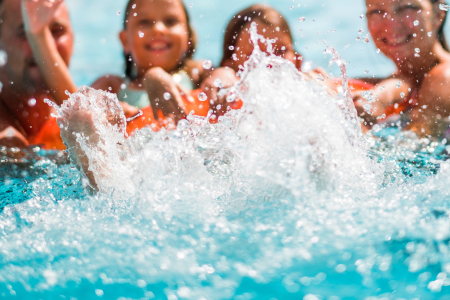Swimming pools are a source of endless fun and relaxation during hot months. They are also great for family fun and fitness. But, if you are a pool owner, a parent, or simply someone who enjoys spending time by the water, it is essential to prioritize safety when it comes to swimming pools. In this blog, we will review common pool hazards and provide tips on preventing accidents and injuries. So, let us make a splash as we embark on this journey of understanding and promoting pool safety for everyone’s peace of mind.
Common Pool Hazards
Drowning and Near-Drowning Incidents
Drowning is the most significant risk associated with a swimming pool and can occur quickly and unnoticed. Children are at the highest risk, but adults can also drown if they are not good swimmers or if alcohol is involved. Near-drowning accidents, which can result in brain damage and long-term injury, can occur when someone has been underwater too long and is not breathing. To prevent drowning and near-drowning incidents, it is important to have adults supervise children, teach them swimming skills, and enforce pool rules. Additionally, there should be a designated “watcher” who monitors everyone near or in the water, regardless of age and swimming ability.
Slips, Trips, and Falls Around the Pool Area
The pool area can be slippery and uneven, leading to slips, trips, and falls. This can lead to injuries such as broken bones, sprains, and cuts. To prevent these accidents, it is important to keep the pool area clean and dry, lay out non-slip mats, and install pool fencing and barriers.
Exposure to Chemicals and Poisoning
Pool chemicals such as chlorine and acid are necessary to maintain water quality but can be dangerous if improperly handled. Exposure to chemicals can cause skin and eye irritation, respiratory problems, and in severe cases, poisoning. To avoid chemical exposure and poisoning, it is important to follow safe handling and storage practices, wear protective clothing, and store chemicals in a locked cabinet out of the reach of children.
How to Prevent Pool-Related Accidents
Installing Pool Barriers and Safety Covers
Installing pool barriers such as fences, gates, and alarms can prevent young children from entering the pool without adult supervision. Safety covers can also provide additional protection and prevent accidental falls into the pool. Research national and local guidelines to ensure that your pool barriers are following recommended heights, materials, spacing, etc.
Providing Adult Supervision for Children
Children should always be supervised in and around the pool, even if they can swim. Adults should always be within reach of children and avoid distractions such as reading or using electronic devices.
Enforcing Pool Rules and Guidelines
Establishing and enforcing pool rules can prevent accidents and injuries. Rules such as “no running or diving,” “no glass or food near the pool,” and “no swimming alone” can promote safe poolside behavior.
Proper Storage and Handling of Pool Chemicals
Pool chemicals should be stored in a cool, dry, and well-ventilated area, separate from other household chemicals. They should also be kept in their original containers and out of the reach of children. When handling pool chemicals, it is important to follow the manufacturer’s instructions, wear protective clothing, and never mix chemicals.
Emergency Preparedness
Have a First Aid Kit and Rescue Equipment on Hand
A well-stocked first aid kit should be kept near the pool, and all family members and caregivers should know how to use it. Rescue equipment such as a pool safety ring or floatation, a shepherd’s crook, and a grab bar should also be easily accessible.
Learn CPR and Other Life-Saving Techniques
Knowing CPR (Cardiopulmonary Resuscitation) and other life-saving techniques can save lives in an emergency. Parents and caregivers should consider taking a CPR and first aid course to be prepared for pool emergencies.
Develop an Emergency Action Plan
An emergency action plan should be developed and practiced by all family members and caregivers. The plan should include instructions on what to do in an emergency, such as calling 911 and performing CPR.
Conclusion
Pool safety should be a top priority for all pool owners and users. Awareness of common pool hazards and preventing accidents and injuries can create a safe and enjoyable environment for all. Installing pool barriers and safety covers, supervising swimmers, enforcing pool rules and guidelines, and properly storing and handling pool chemicals are important steps to preventing accidents. In addition, having a well-stocked first aid kit, learning CPR and other life-saving techniques, and developing an emergency plan are critical to responding to emergencies.
Pool safety is not just the pool owner’s responsibility. Any person near the pool or swimming in it should know the rules and guidelines for pool safety and take responsibility for their actions. By working together and prioritizing pool safety, we can ensure everyone has a safe and enjoyable summer.

